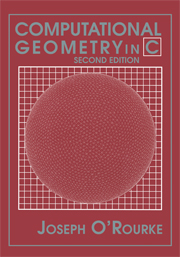6 - Arrangements
Published online by Cambridge University Press: 05 June 2012
Summary
INTRODUCTION
Arrangements of lines (and planes) form the third important structure used in computational geometry, as important as convex hulls and Voronoi diagrams. And as we glimpsed at the end of the previous chapter, and will see more clearly in Section 6.6, all three structures are intimately related. An arrangement of lines is shown in Figure 6.1. It is a collection of (infinite) lines “arranged” in the plane. These lines induce a partition of the plane into convex regions (called cells, or faces), segments or edges (between line crossings), and vertices (where lines meet). The example in the figure has V = 45 vertices, E = 100 edges, and F = 56 faces; not all of these are visible within the limited window of the figure. It is this partition that is known as the arrangement. It is convenient to view the faces as open sets (not including their edges) and the edges as open segments (not including their bounding vertices), so that the dissection is a true partition: Its pieces cover the plane, but the pieces are disjoint from one another, “pairwise disjoint” in the idiom preferred by mathematicians.
Arrangements may seem too abstract to have much utility, but in fact they arise in a wide variety of contexts. Here are four; more will be discussed in Section 6.7.
1. Visibility Graphs
[…]
- Type
- Chapter
- Information
- Computational Geometry in C , pp. 193 - 219Publisher: Cambridge University PressPrint publication year: 1998



